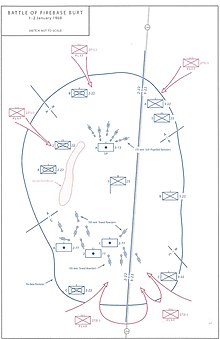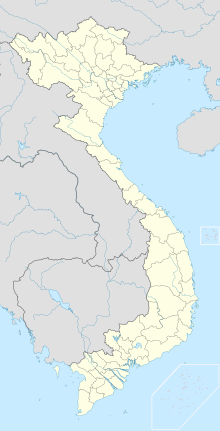New Year's Day battle of 1968
| New Year's Day battle of 1968 | |||||||
|---|---|---|---|---|---|---|---|
| Part of the Vietnam War | |||||||
 Map of the battle of Firebase Burt | |||||||
| |||||||
| Belligerents | |||||||
|
|
| ||||||
| Units involved | |||||||
|
2nd and 3rd Battalions, 22nd Infantry Regiment Battery B, 5th Battalion, 2nd Artillery Regiment Battery A, 3rd Battalion, 13th Artillery Regiment Battery D, 71st Artillery Regiment Batteries A and C, 2nd Battalion, 77th Artillery Regiment | 271st Regiment and 272nd Regiment, 9th Division | ||||||
| Casualties and losses | |||||||
| 23 killed[1] | U.S. body count: 348 killed[1] | ||||||
Location within Vietnam | |||||||
The New Year's Day battle of 1968 was a military engagement during the Vietnam War in Tây Ninh province that began on the evening of 1 January 1968. It involved units assigned to the U.S. 25th Infantry Division and two regiments of the People's Army of Vietnam (PAVN). The battle was known as the Battle of Fire Support Base Burt (Battle of FSB Burt), or the Battle of Suoi Cut.[2] This is not the same location as Suối Cắt village in northern Vietnam.
Background
[edit]In late 1967, Pope Paul VI had declared 1 January 1968 a day of peace and persuaded the South Vietnamese and the Americans to observe a truce. In a released statement, the Viet Cong (VC) also agreed to observe a 36-hour ceasefire.[3] The 25th Infantry Division had been patrolling the Vietnamese-Cambodian border in Operation Yellowstone to interdict PAVN/VC coming down the Ho Chi Minh trail. The 25th Infantry Division had set up a two-battalion perimeter, the 2nd and 3rd Battalions of the 22nd Infantry Regiment, with artillery 7 miles (11 km) from the Cambodian border in Tay Ninh Province outside a village called Suoi Cut.[1] The fire support position, named Fire Support Base Burt (11°34′52″N 106°22′19″E / 11.581°N 106.372°E), was located near the junction of Highways 244 and 246, close to Black Virgin Mountain. Troops had that day recently set up a landing zone (LZ) for supply helicopters. Once the helicopter pad had been constructed, supplies could be flown in, and on 1 January the 25th Infantry Division's Christmas mail had arrived. Soldiers spent the day opening packages from their families.[4]
Battle
[edit]This section needs expansion. You can help by adding to it. (October 2022) |
On the night of 1 January, six hours before the truce was to have ended, a 2,500-man force made up of elements of the 271st and 272nd Regiments of the VC 9th Division attacked the American position.[5] The PAVN/VC attacked in three waves and were able to infiltrate the perimeter.[1][4] The first wave was launched after a heavy mortar attack at 23:30. A little after midnight, another attack was launched and a third human wave attack around 01:00. The Americans were finally able to repel the attacks by using air and artillery support. Air support was provided by attack helicopters and AC-47 Spooky gunships. In total, 28 air sorties were launched against the PAVN. The Americans said that they counted 348 enemy soldiers killed in the action. By comparison, American forces suffered 23 killed. Last contact with enemy units occurred at 05:15 when they withdrew from the battleground. The remnants of the PAVN/VC were pursued to the south and southeast.[1][2]
Aftermath
[edit]Thirty days later, on 31 January 1968, PAVN and VC forces launched the Tet Offensive throughout South Vietnam. When Oliver Stone returned to the U.S., he was puzzled that the New Year's attack had received no media coverage. For some time, he thought he might have imagined the events of January 1 until, at a reunion of the men of the 25th Infantry Division, other Vietnam vets who were there that night were able to confirm the battle did indeed take place.[6]
In popular media
[edit]Among the soldiers serving in the American units during the battle were future writer Larry Heinemann and future film director Oliver Stone.[7][8] Heinemann later wrote a book about his Vietnam experiences titled Black Virgin Mountain: A Return to Vietnam,[9] and Stone would direct the dramatization of the battle in the 1986 film Platoon. The final battle scene of Platoon is a dramatization of the real battle Stone experienced. Survivors of the battle often relate how close to actual events the fighting was to what is seen on screen.[7]: 107
References
[edit]![]() This article incorporates public domain material from websites or documents of the United States Army Center of Military History.
This article incorporates public domain material from websites or documents of the United States Army Center of Military History.
- ^ a b c d e Johnson, Thomas A. (3 January 1968). "G.I.'s Kill 348 in Repelling Foe's Attack During Truce". The New York Times. p. 1. Retrieved 25 February 2010.(subscription required)
- ^ a b Trass, Adrian (2017). The U.S. Army Campaigns of the Vietnam War: Turning Point 1967-1968 (PDF). Center of Military History. pp. 28–30.
- ^ Kurlansky, Mark (5 January 2004). "Excerpt from '1968: The Year That Rocked the World'". USA Today. Retrieved 25 February 2010.
- ^ a b Dwyer, Ed (25 March 2008). "1968: Trauma". AARP the Magazine. Retrieved February 23, 2010.
- ^ "Ceasefire hardly one at all". The Miami News. The Palm Beach Post. p. 5.
- ^ Stone, Oliver (Director) (19 December 1986). "Platoon". IMDb (Motion picture; Documentary Commentary). Retrieved 11 July 2012.
- ^ a b Bates, Milton J. (1996). The wars we took to Vietnam: cultural conflict and storytelling. University of California Press. p. 106. ISBN 0520204336.
- ^ Gaijinass (27 February 2010). "Platoon: The story of Oliver Stone in Vietnam". gaijinass. Archived from the original on 20 June 2010. Retrieved March 3, 2010.
- ^ Heinemann, Larry (2005). Black Virgin Mountain: a return to Vietnam. Doubleday. p. 194. ISBN 038551221X.

